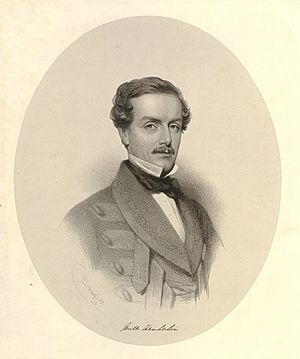Neville Bowles Chamberlain facts for kids
Quick facts for kids
Sir Neville Bowles Chamberlain
|
|
|---|---|
 |
|
| Born | 10 January 1820 Rio de Janeiro, Brazil |
| Died | 18 February 1902 (aged 82) Lordswood, Hampshire, United Kingdom |
| Allegiance | |
| Service/ |
Bengal Army Madras Army |
| Years of service | 1837–1886 |
| Rank | Field Marshal |
| Commands held | Madras Army |
| Battles/wars | First Anglo-Afghan War Gwalior campaign Second Anglo-Sikh War Indian Rebellion Second Anglo-Afghan War |
| Awards | Knight Grand Cross of the Order of the Bath Knight Grand Commander of the Order of the Star of India |
| Spouse(s) | Charlotte Cuyler Reid |
| Relations | Sir Henry Chamberlain, 1st Baronet (father) |
Field Marshal Sir Neville Bowles Chamberlain (born January 10, 1820 – died February 18, 1902) was a very important British army officer. He served in British India for many years. He fought in several major wars and later became the Commander-in-Chief of the Madras Army.
Contents
Early Life and Education
Neville Chamberlain was born in Rio de Janeiro, Brazil. His father, Sir Henry Chamberlain, was a British diplomat there. Neville was the third of his sons. His older brother became an admiral, and two younger brothers also joined the army.
He grew up in England and was taught by a private tutor. He also went to a school in Shooter's Hill, London. In 1833, he joined the Royal Military Academy, Woolwich, a famous military school. However, he left after a year because he wasn't likely to pass the final exams.
After leaving school, he wanted to join a group of soldiers going to Spain. Instead, he was encouraged to start a military career in India. With help from his father's friends, he became a junior officer, called an ensign, in the Bengal Native Infantry in 1837.
Military Career in India
Chamberlain traveled to India by ship, arriving in Madras in May 1837. After a short stay, he moved to Calcutta to get used to his new home. Later that year, he joined the 12th Regiment at Barrackpore. A few months later, he moved to Lucknow with the 55th Regiment.
First Anglo-Afghan War
In 1838, Chamberlain joined the 16th Regiment in Delhi. This regiment was preparing for the First Anglo-Afghan War. He was part of a large army known as the Army of the Indus. He fought in several battles, including the Battle of Ghazni in July 1839. He was wounded multiple times during this war.
He became a lieutenant in 1842. He then joined a local army unit and marched from Kandahar to Kabul. During the army's retreat from Kabul, he was wounded again. This happened first at Landi Kotal and then at Ali Masjid in late 1842.
Further Campaigns
In 1843, he joined the Governor-General's Bodyguard. He took part in the Battle of Maharajpur in December 1843 during the Gwalior campaign. Later, he became a military secretary to the Governor of Bombay. In 1848, he took on another important role with the Bengal Irregular Cavalry.
Second Anglo-Sikh War
Chamberlain also fought in the Second Anglo-Sikh War. He was present at the Battle of Chillianwala in January 1849 and the Battle of Gujrat in February 1849. After these battles, he was promoted to captain and then to major. He worked as an assistant commissioner in different districts, including Rawalpindi District and Hazara District.
He was promoted to lieutenant-colonel in 1854. He then took command of the Punjab Irregular Frontier Force. He led several missions against local tribes along the border.
Indian Rebellion of 1857
During the Indian Rebellion of 1857, Chamberlain served as the Adjutant-General of the Indian Army. This was a very important leadership role. He was seriously wounded during the Siege of Delhi in July 1857. For his bravery, he received an award called the Companion of the Order of the Bath. He was also promoted to colonel.
Chamberlain returned to lead the Punjab Irregular Frontier Force in 1858. He led them during the Ambela Campaign in 1863. He was severely wounded again during this campaign. He was recognized for his distinguished service and promoted to major-general in 1864. He received more honors, including the Knight Commander of the Order of the Star of India.
He was promoted to lieutenant-general in 1872. He received even higher honors, becoming a Knight Grand Commander of the Order of the Star of India and a Knight Grand Cross of the Order of the Bath.
Commander-in-Chief of Madras Army
In 1876, Chamberlain became the Commander-in-Chief of the Madras Army. He was promoted to full general in 1877. He was sent on an important mission to meet the leader of Afghanistan, Sher Ali Khan. However, Sher Ali Khan refused to let him enter the country. This refusal helped start the Second Anglo-Afghan War in November 1878.
He was also a member of the Madras Legislative Council. For a few months, he acted as the military member of the council for the Governor-General of India. He left India in 1881 and retired in 1886.
Later Life and Legacy
After retiring, Sir Neville Chamberlain lived in Lordswood, England. He was an active member of his local church. He also expressed concerns about British policy during the Boer War between 1899 and 1901.
He received his final promotion to field marshal in 1900. Sir Neville Chamberlain passed away on February 18, 1902, at the age of 82. He was buried near Southampton.
Family Life
In 1873, Neville Chamberlain married Charlotte Cuyler Reid. She was the daughter of another military officer, Major-General Sir William Reid. Charlotte passed away in 1896. They did not have any children.

